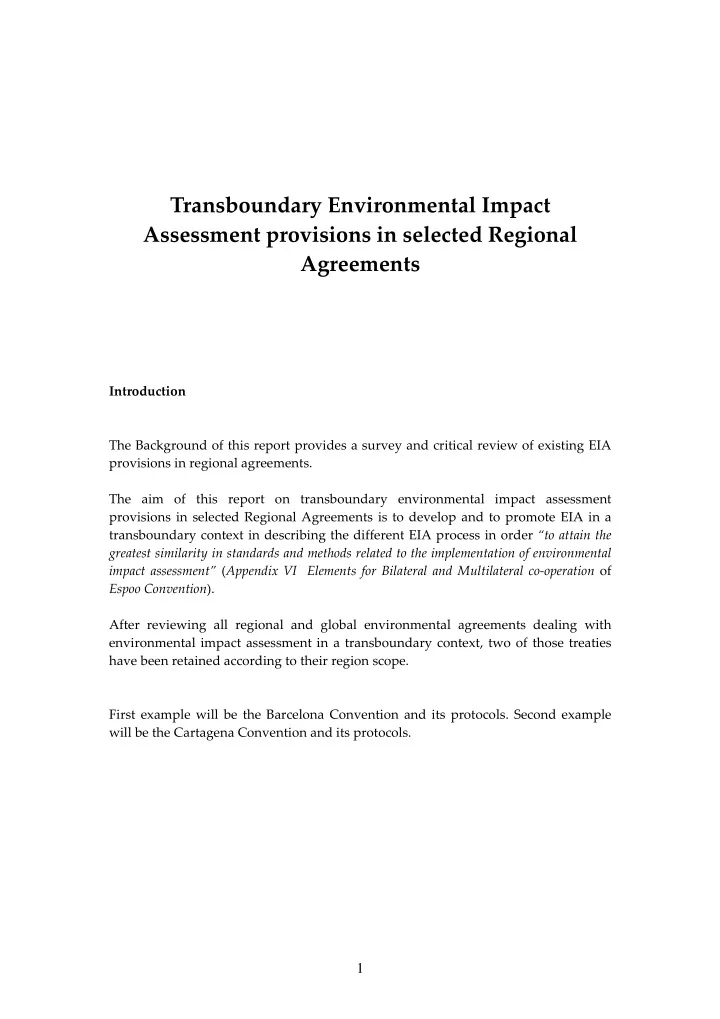

Transboundary Environmental Impact Assessment provisions in selected Regional Agreements Introduction The Background of this report provides a survey and critical review of existing EIA provisions in regional agreements. The aim of this report on transboundary environmental impact assessment provisions in selected Regional Agreements is to develop and to promote EIA in a transboundary context in describing the different EIA process in order “to attain the greatest similarity in standards and methods related to the implementation of environmental impact assessment” ( Appendix VI Elements for Bilateral and Multilateral co-operation of Espoo Convention ). After reviewing all regional and global environmental agreements dealing with environmental impact assessment in a transboundary context, two of those treaties have been retained according to their region scope. First example will be the Barcelona Convention and its protocols. Second example will be the Cartagena Convention and its protocols. 1
Example 1. Analysis of Transboundary Environmental impact assessment provisions under the Barcelona Convention and its protocols The Convention for the protection of the Mediterranean Sea against pollution was adopted on 16 February 1976 in Barcelona and entered in force on 12 February 1978. By 1 February 2003, 22 countries including the European Community, were Parties to this Convention. The Barcelona Convention has been modified by the Barcelona amendments on 10 June 1995 (not yet in force) and will be named Convention for the Protection of the Marine Environment and the Coastal Region of the Mediterranean (Barcelona Convention). Protocols related to the Barcelona Convention are: � Protocol for the Prevention of Pollution of the Mediterranean Sea by Dumping from Ships and Aircraft (Dumping Protocol) , Barcelona, 16 February 1976 (entered into force on 12 February 1978). Amended in Barcelona the 10 June 1995, this Protocol will be Protocol for the Prevention and Elimination of Pollution of the Mediterranean Sea by Dumping from Ships and Aircraft or Incineration at Sea (not yet in force). � Protocol Concerning Co-operation in Combating Pollution of the Mediterranean Sea by Oil and Other Harmful Substances in Cases of Emergency (Emergency Protocol) , Barcelona, on 16 February 1976 (entered into force on 12 February 1978). � Protocol Concerning Co-operation in Preventing Pollution from Ships and, in Cases of Emergency, Combating Pollution of the Mediterranean Sea , Valletta, 25 January 2002 (entered into force on 17 March 2004). � Protocol for the Protection of the Mediterranean Sea against Pollution from Land-Based Sources (LBS Protocol), Athens, on 17 May 1980 (entered into force on 17 June 1983). Amended in Syracuse, 7 March 1996, this protocol will be named Protocol for the Protection of the Mediterranean Sea against Pollution from Land-Based Sources and Activities (not yet in force). � Protocol Concerning Mediterranean Specially Protected Areas (SPA Protocol) , Geneva, on 3 April 1982 (entered into force on 23 March 1986). � Protocol Concerning Specially Protected Areas and Biological Diversity in the Mediterranean (SPA and Biodiversity Protocol) , Barcelona, on 10 June 1995 (entered into force on 12 December 1999). � Protocol for the Protection of the Mediterranean Sea against Pollution Resulting from Exploration and Exploitation of the Continental Shelf and the Seabed and its Subsoil (Offshore Protocol) , Madrid, on 14 October 1994 (not yet in force). 2
� Protocol on the Prevention of Pollution of the Mediterranean Sea by Transboundary Movements of Hazardous Wastes and their Disposal (Hazardous Wastes Protocol) , Izmir, on 1 October 1996 (not yet in force). The main objectives of the Barcelona Convention and its protocols are the assessment, control, cooperation and protection of the marine environment and coastal region of the Mediterranean Sea area. These objectives could be achieved through the application of environmental impact assessment -I- in a transboundary context - II - and public participation - III. I. Environmental Impact Assessment procedure In order to protect the environment and to guarantee sustainable development, the Article 4 on General Obligations 1 of the Convention for the Protection of the Mediterranean Sea against pollution , adopted in Barcelona, 9 February 1976 2 provides the application of the transboundary EIA to activities that are likely to cause a significant adverse impact on Mediterranean Sea by all the Parties. Although, this provision does not include a list of activities that could trigger environmental impact assessment, it offers more flexibility by covering all activities that are likely to cause a significant impact on marine environment. Nevertheless, the Barcelona Convention does not provide any guidance to assess when an activity is likely to cause a significant impact 3 . In this case, an activity with a non-negligible effect on Mediterranean environment can be considered to have a significant impact on Mediterranean environment. According to the Barcelona Convention, the competent authority to authorize activities “ that are likely to cause a significant adverse impact on the marine environment ” 4 can only 1 Article 4 General Obligations 3. In order to protect the environment and contribute to the sustainable development of the Mediterranean Sea Area, the Contracting Parties shall: (…) (c) undertake environmental impact assessment for proposed activities that are likely to cause a significant adverse impact on the marine environment and are subject to an authorization by competent national authorities; (d) promote cooperation between and among States in environmental impact assessment procedures related to activities under their jurisdiction or control which are likely to have a significant adverse effect on the marine environment of other States or areas beyond the limits of national jurisdiction, on the basis of notification, exchange of information and consultation; 2 http://eelink.net/~asilwildlife/barcelona.html 3 At the opposite, to define a significance of impact, the Espoo Convention considers size, location and effects of proposed activity (Appendix III) 4 Article 4 General Obligations 3. In order to protect the environment and contribute to the sustainable development of the Mediterranean Sea Area, the Contracting Parties shall: (…) 3
Recommend
More recommend